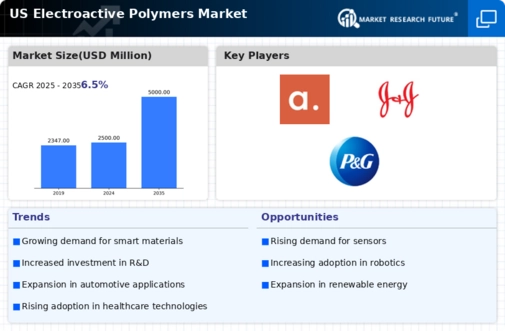Rising Demand for Smart Materials
The electroactive polymers market is experiencing a notable surge in demand for smart materials, which are increasingly utilized in various applications such as sensors, actuators, and artificial muscles. This trend is driven by the growing need for advanced materials that can respond to external stimuli, enhancing functionality in sectors like robotics and consumer electronics. The market for smart materials is projected to reach approximately $30 billion by 2026, indicating a robust growth trajectory. As industries seek to innovate and improve product performance, the integration of electroactive polymers into smart systems is likely to become more prevalent, thereby propelling the electroactive polymers market forward.
Expansion in Automotive Applications
The automotive sector is a significant driver for the electroactive polymers market, as manufacturers increasingly adopt these materials for various applications, including sensors, actuators, and lightweight components. The push for electric vehicles (EVs) and advanced driver-assistance systems (ADAS) has led to a heightened demand for materials that can enhance performance and reduce weight. It is estimated that the automotive segment could account for over 25% of the total electroactive polymers market by 2027. This shift towards more efficient and responsive automotive technologies is likely to stimulate further growth in the electroactive polymers market, as manufacturers seek to leverage the unique properties of these materials.
Growing Interest in Wearable Technology
The electroactive polymers market is witnessing a growing interest in wearable technology, which relies on materials that can provide flexibility, comfort, and responsiveness. As consumers increasingly seek devices that can monitor health and fitness, the demand for electroactive polymers in wearable applications is expected to rise. This trend is supported by the projected growth of the wearable technology market, which is anticipated to reach $60 billion by 2025. The integration of electroactive polymers into wearables not only enhances functionality but also contributes to the overall user experience, thereby driving the electroactive polymers market as manufacturers explore innovative designs and applications.
Advancements in Energy Harvesting Technologies
The electroactive polymers market is significantly influenced by advancements in energy harvesting technologies, which aim to convert ambient energy into usable electrical energy. These technologies are increasingly being integrated into various applications, including self-powered sensors and smart devices. The potential for electroactive polymers to play a crucial role in energy harvesting is becoming more apparent, as they offer unique properties that can enhance efficiency and performance. The energy harvesting market is projected to grow at a CAGR of over 15% through 2028, suggesting that the electroactive polymers market could see substantial growth as these technologies gain traction and find broader applications.
Increased Investment in Research and Development
Investment in research and development (R&D) within the electroactive polymers market is on the rise, as companies and institutions strive to innovate and enhance the capabilities of these materials. This focus on R&D is crucial for developing new applications and improving existing technologies, which could lead to breakthroughs in fields such as biomedical devices and energy harvesting. The U.S. government has also shown interest in funding projects that explore the potential of electroactive polymers, further driving advancements in the market. As R&D efforts intensify, the electroactive polymers market is likely to benefit from new discoveries and applications that could reshape its landscape.

















Leave a Comment